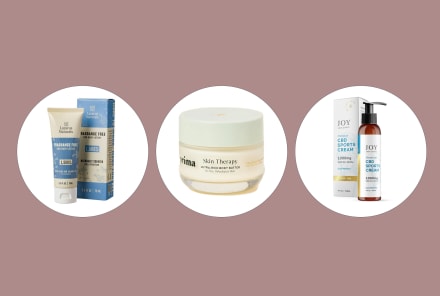Advertisement
The 12 Worst Cancer-Causing Ingredients In Everyday Products



The EWG’s annual Dirty Dozen breaks down which fruits and vegetables have the most pesticides and which have the fewest. This year, they’ve taken their list a step further and tackled the toxins that lurk outside grocery stores.
In response to years of research linking environmental toxins and cancer, the EWG just released their Cancer Prevention Dirty Dozen, which lists 12 carcinogens that lie in everyday products like packaging, cosmetics and furniture.
“Given that we live in a sea of chemicals, it makes sense to begin reducing exposures to ones we know are bad actors,” the report reads.
Here’s a list of EWG’s top offenders, what they can do to your body, where to find them, and how to avoid them.
1. Bisphenol A (BPA)
You’ve probably heard talk of the dangers of BPA before — it’s a chemical used in the plastic lining of food and beverage containers and it’s been linked to a slew of cancers. Though a few major companies are phasing BPA out of their packaging, it’s still in plastics marked “PC” and “recycling #7.” Avoid these, and opt for fresh foods over canned ones whenever possible.
2. Atrazine
Atrazine is of the most widely used herbicides in the US and a study by the NRDC found that it has made its way into more than 80% of our drinking water. Filter your tap water to avoid this endocrine disruptor and potential carcinogen.
3. Organophosphate Pesticides
Major food corporations like Monsanto use organophosphates to destroy the nervous system of pests, but they’re not so great for humans either. Buy organic to avoid produce that could be contaminated with residue from the pesticide.
4. Dibutyl Phthalate (DBP)
DBP is linked to cancer and fertility struggles and it’s been banned in most personal care products like nail polishes and perfumes. You can still find it in some flexible plastics like shower curtains and raincoats, so it’s a good idea to look for natural alternatives to soft plastics.
5. Lead
Lead harms almost every system in the body, so be careful when removing that stubborn old paint from walls, as it could hold traces of the dangerous chemical.
6. Mercury
Mercury exposure is super dangerous during pregnancy, but it’s important for everyone to keep their levels in check. Monitor your intake of large fish like tuna and swordfish — they’re the ones that usually have the highest mercury buildup in their system.
7. PFCs
PFCs are used in grease and stain-repellent coatings. The EWG recommends avoiding pre-treated carpets and furniture that have been treated with repellents.
8. Phthalates
Phthalates are often added to perfumes to help them cling to the skin longer, but they’re really not something you want on your body. They’ve been shown to screw up hormone levels and disrupt brain function. Avoid products that have the word “fragrance” on the ingredient list — this is usually code for phthalates, which don’t have to be explicitly labeled.
9. Diethlyhexyl Phthalate (DEHP)
DEHPs are the most commonly used class of phthalates, and the same rules of avoidance apply for them.
10. PBDEs
This type of fire retardant was used to treat upholstered furniture, mattresses and pillows until it was pulled from the market for high toxicity levels. Invest in some new furniture and consider getting rid of those vintage pieces manufactured before 2005.
11. Triclosan
Triclosan has been linked to cancer and heart disease, but it’s still an ingredient in many antibacterial products. Soap alternatives like essential oils and DIY cleansers offer a safer approach to cleaning.
12. Nonylphenol
Nonylphenols are everywhere — from laundry and dish detergents to paints and personal care products. Follow the EWG’s Healthy Cleaning Guide to learn how to nix them from your everyday routine.
Watch Next
Enjoy some of our favorite clips from classes
Enjoy some of our favorite clips from classes
What Is Meditation?
Mindfulness/Spirituality | Light Watkins
Box Breathing
Mindfulness/Spirituality | Gwen Dittmar
What Breathwork Can Address
Mindfulness/Spirituality | Gwen Dittmar
The 8 Limbs of Yoga - What is Asana?
Yoga | Caley Alyssa
Two Standing Postures to Open Up Tight Hips
Yoga | Caley Alyssa
How Plants Can Optimize Athletic Performance
Nutrition | Rich Roll
What to Eat Before a Workout
Nutrition | Rich Roll
How Ayurveda Helps Us Navigate Modern Life
Nutrition | Sahara Rose
Messages About Love & Relationships
Love & Relationships | Esther Perel
Love Languages
Love & Relationships | Esther Perel
What Is Meditation?
Box Breathing
What Breathwork Can Address
The 8 Limbs of Yoga - What is Asana?
Two Standing Postures to Open Up Tight Hips
How Plants Can Optimize Athletic Performance
What to Eat Before a Workout
How Ayurveda Helps Us Navigate Modern Life
Messages About Love & Relationships
Love Languages
Advertisement

8 Dietitians Share The Nutrition Advice They Actually Follow
Molly Knudsen, M.S., RDN

Why Women Are Twice As Likely To Struggle With Depression & Anxiety
Phyllis E. Greenberger, MSW

8 Dietitians Share The Nutrition Advice They Actually Follow
Molly Knudsen, M.S., RDN

Why Women Are Twice As Likely To Struggle With Depression & Anxiety
Phyllis E. Greenberger, MSW













